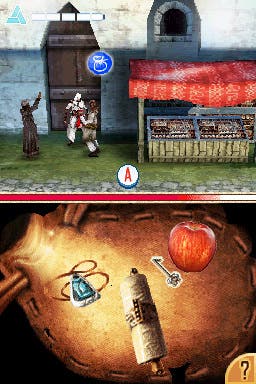Assassin's Creed: Altair's Chronicles
Al-Mualims will be cross.
The Nintendo DS isn't the most obvious place to continue the story of Altair, master assassin of Ubisoft's biggest game of 2007, so developer Gameloft, er, hasn't. Instead, Altair's Chronicles delves into his past, prior to that fateful trip into Solomon's Temple and the events that followed it. This is an odd decision, because Assassin's Creed itself was a game about personal redemption, charting Altair's downfall and his subsequent journey toward absolution and enlightenment - the point being that when he began the game he was a bit of an arrogant dolt.
Gameloft gets around this by reducing the DS game's lead character to a bit of an empty eagle smock. The (unvoiced) dialogue reads a bit like him, but the mystery and intrigue that drove you through the home console game are replaced with a simple quest to retrieve a Templar relic, a chalice, and all the sci-fi stuff about Desmond Miles and Abstergo is ignored, save for menu screens that look a bit like the Animus. Eliciting that kind of recognition in the player - clear, but without any implications for the mother series - seems to be Gameloft's brief, because Altair's Chronicles is very deliberately designed to appear part of the Assassin's Creed canon without really having much in common with it narratively and mechanically.
What we have instead is a platform game split across a number of set levels where precision jumping, evading traps and doing a bit of hackandslash gets you to the end. Progression is left to right, but you can move in and out of the screen in the manner of an old 16-bit scrolling beat-'em-up, albeit with a bit more fluency, and there are touch-screen mini-games that revisit concepts like pickpocketing and interrogation. The former is done by scrubbing the screen to reveal the contents of a victim's bag, and then dragging the desired item through a maze of other trinkets, some of which move around to increase the difficulty. Amusingly, interrogation is a rip-off of Elite Beat Agents (or Osu! Tatakae! Ouendan to its Japanese friends), the rhythm-action game where you tap numbered icons as circles close around them, except here the icons are located at points on the victim's body and the ball-rolling bits are metaphors for arm-twisting.

The running, jumping and climbing is necessarily basic next to the climb-everywhere parkour platforming of Assassin's Creed itself. You can run up low walls to grab the lip and then pull yourself up, and holding the right shoulder button reduces Altair to walking pace - good for avoiding the attention of the smattering of guards walking simple patrol routes on the ground, sneaking up on dozy rooftop sentries, and maintaining your balance on narrow beams. Using the touch-screen mini-map as a guide, you criss-cross the rooftops via beams, jumps, crumbling wooden shacks, swing-ropes, moving platforms and shallow ledges, dodging repeating spike-traps, and vents spewing fire or water, as you go. There are also occasional, basic puzzles with which to contend. Shorn of the open world and parkour, parallels with the old Prince of Persia are much more obvious than they were on 360 or PS3.
In combat, too, much is reconstituted. Enemies attack one by one and it's possible to block their sword blows with the right shoulder button and counter by pressing X or Y as they begin their downswing. With the right timing, it's possible to daze and execute an adversary, or on the offensive a range of button-mashing combos can be used to reduce health-bars. Evasion plays less of a part than it did before - there's no hiding in haystacks or rooftop shacks - although it is still possible, albeit less so when enemies respawn regularly. Stealth, again, is less important, and the eventual assassinations are a case of walking up to your enemy - who helpfully often has his backed turned, even as the battle music pumps away and your alert status flashes red - and pressing A.


